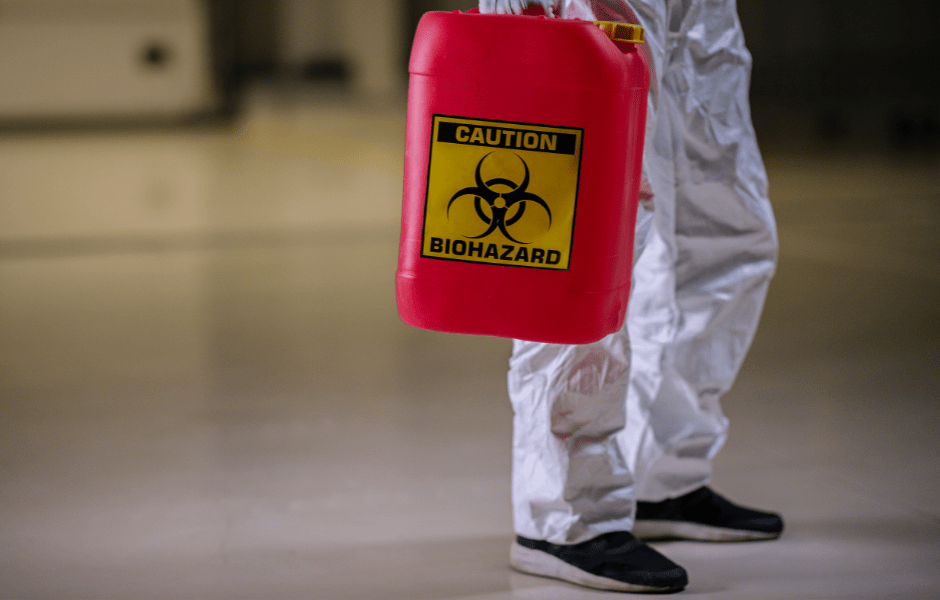
How MedSharps Can Help You Avoid Big Fines and Penalties
In October 2021, Fortune 500 Company DuPont made headlines when the Justice Department, the EPA, and the state of Texas fined the chemical manufacturer $3.1 million for a laundry list of violations from their chemical manufacturing plant in Orange, Texas. These infractions included improper disposal of hazardous waste causing water and air pollution. More specifically, the violations included the improper use of chemicals, improper disposal of wastewater and improper disposal of waste without a permit.
For a global company like DuPont, a three-million-dollar fine can easily be paid and they can learn from their mistakes and move on with business as usual. But what about small to mid-sized businesses? A large fine can have a significant impact on the longevity and success of these businesses and can ultimately lead to closure.
Big fines and penalties from OSHA, the EPA, and other federal, state and local agencies can be avoided if you have a solid compliance plan. It all starts with knowing the rules and the situations that can lead to problems. When it comes to waste disposal, here are some common issues that can lead to violations, and, if not corrected, stiff fines and penalties.
Six Common Causes of Violations and Penalties
1. Inadequate employee training – According to OSHA, all employees with occupational exposure, whether they are full-time, part-time, or temporary workers must receive initial and annual training. This includes general training outlined in OSHA standards as well as site-specific training by a person who is knowledgeable in the subject matter. Regardless of your plans and processes for handling, storing, and disposing of medical waste, they are only as effective as your employee’s ability to execute them. Many violations can be avoided simply by offering educational training on a regular basis, so all employees know how to classify hazardous materials and dispose of them the right way. One very common violation is having incomplete or missing training records. In case of an inspection, always keep your training documentation current and ready for review.
2. Inappropriate medical waste containers and improper labeling – It’s no surprise that this ranks so high on the list of common violations. Having the right container for medical waste would seem like an easy thing to get right but, too often, this is the reason for penalties and fines. For example, used sharps (anything used for injecting or cutting) need to be kept in a sturdy, puncture-proof container that has been certified as tamper-proof and leak-proof. Containers that are damaged or have the potential to leak are violations of the OSHA standard. Containers should be labeled to segregate the waste by type to prevent contamination. An employee who puts a used needle into a red biohazard liner is committing a violation as the liners are for non-sharp infectious waste and blood products, not for sharps. Labelling hazardous waste bins and bags is also a critical process to ensure proper disposal. Depending on the size of the facility, the possibility of a violation goes up due to the amount of waste being handled. Common violations can include a missing date of accumulation label or using the wrong-colored bag.
3. Not knowing your waste generator status – Different rules apply depending on the generator status of your facility. For example, EPA guidelines state that a facility with an SQG (Small Quantity Generator) designation is allowed to keep quantities of medical waste under 6,000 kilograms on site for up to 180 days. However, a facility designated as an LQC (Large Quantity Generator) has no limitations in terms of amount of medical waste but can only keep it on site for 90 days. To further complicate matters, in Texas, you can be categorized with CESQ (Conditionally Exempt Small Quantity) status if you produce a small amount of waste and meet certain conditions. The EPA and TCEQ require all facilities who generate medical waste to track the quantities of waste to determine their generator status and follow the guidelines that apply. Not knowing your facility’s generator status can lead to mismanagement of hazardous waste which can lead to penalties and fines.
4. Illegal dumping of hazardous waste in dumpsters or drains – One very common violation, unfortunately, is the practice of employees placing trash in dumpsters onsite or even using drains to dispose of medical waste materials. Whether this practice is done on purpose or due to the employee not being educated on medical waste procedures, it is illegal and a violation that carries heavy fines and could potentially cause harm to the environment. Regardless of the facility’s waste generator status, management is responsible for properly training employees to follow the correct protocols when it comes to disposing of medical waste.
5. Improper waste segregation – This also seems like a no-brainer; keep your regular trash separate from medical waste. All facilities are required to identify the waste they are disposing of and follow the protocols for that type of waste. Some wastes are commonly overlooked, like cotton, gauze, or other blood-stained materials that can be thrown into the regular trash receptacles. Other violations occur when an employee isn’t aware that a material is considered hazardous. Regular training and research into local, state, and federal agencies is the only way to ensure that hazardous materials being disposed of correctly. For example, solvents or batteries should never be placed in medical waste containers. This is a common violation and could incur penalties, fines, and, in extreme cases, jail.
6. Failure to conduct regular inspections – Conducting regular inspections is the best method for determining if your facility is compliant and following protocols that meet the standards. These inspections should include evaluating waste containers for overall condition and proper labeling. They should determine if waste segregation and waste disposal protocols are being followed based on training guidelines. Failure to conduct and document regular inspections leaves your company at risk for big fines and penalties.
Getting an investigation query from a federal, state, or local agency can be a stressful and disruptive experience but incurring penalties can be even worse. Monetary fines put a financial burden on your business, but these violations can also point out that you are not prioritizing the safety or your patients and employees.
You can always do the research on your own to come up with your compliance plan. Agencies like OSHA and the EPA provide pages and pages of legal guidelines and regulations, but that can be a time-consuming and frustrating endeavor for smaller companies who might not have the personnel or the know-how to get it done. It’s a daunting task when you consider you have to account for EPA and OSHA regulations on the federal level and then incorporate any state or local guidance into your plan.
Managing the disposal of medical waste and staying compliant is no easy task. Maintaining your knowledge of ever-changing local, state, and federal regulations is a full-time job. With so many moving parts, it’s not hard for one minor detail to slip through the cracks and suddenly you have an inspector at your front door.
At MedSharps, we’re medical waste experts and we’ve done all the research for you. We take pride in staying up to date on all the latest regulatory changes so we know what you can and can’t do with your medical waste.
Visit MedSharps.com today for a free quote. Our educated team of waste experts will help you find the best and most efficient path to OSHA compliance and avoid big fines and penalties.








